Are you planning a cycling trip to Vietnam and wondering how to safely transport your beloved bike? With SIXT.VN, you can explore the best Bike Cases For Air Travel, ensuring your bike arrives in perfect condition for your Vietnamese adventure. Discover reliable options for bike transport and cycling tours in Vietnam, making your journey seamless. SIXT.VN is here to help you with bicycle shipping, luggage transport services, and bike travel tips.
1. What Are Bike Cases For Air Travel And Why Do You Need One?
Bike cases for air travel are specialized containers designed to protect bicycles during transportation on airplanes. You need one to prevent damage to your bike from rough handling, impacts, and other hazards during transit. According to a study by the International Air Transport Association (IATA) in 2023, mishandling of luggage is a significant cause of damage to sporting equipment, including bikes. A proper bike case ensures your bike arrives safely in Vietnam, ready for your cycling adventures.
- Protection: Prevents scratches, dents, and more serious damage.
- Convenience: Makes it easier to handle and transport your bike.
- Airline Compliance: Meets airline regulations for transporting bikes.
2. What Are The Different Types Of Bike Cases Available?
There are primarily two types of bike cases for air travel: soft bags and hard cases. Each has its advantages and disadvantages, depending on your needs and budget. Choosing the right one can significantly impact the safety and convenience of transporting your bike to Vietnam.
2.1. Soft Bike Bags
Soft bike bags are typically made of padded fabric and are lighter and more flexible than hard cases. They are easier to store when not in use, making them a popular choice for cyclists who don’t travel frequently.
- Pros:
- Lighter and easier to carry
- More affordable
- Easier to store when not in use
- Cons:
- Less protection than hard cases
- May require more padding for delicate frames
- More susceptible to damage
2.2. Hard Bike Cases
Hard bike cases are made of rigid materials like plastic or aluminum, providing superior protection for your bike. They are more expensive and heavier but offer the best defense against impacts and mishandling.
- Pros:
- Maximum protection for your bike
- Durable and long-lasting
- Ideal for carbon-framed bikes
- Cons:
- Heavier and more cumbersome
- More expensive
- Requires more storage space
3. What Features Should You Look For In A Bike Case?
When choosing a bike case for air travel to Vietnam, consider the following features to ensure it meets your needs:
3.1. Material And Durability
The material of the bike case determines its durability and level of protection. Hard cases made of high-density polyethylene (HDPE) or aluminum offer the best protection, while soft bags should be made of durable, tear-resistant fabrics with ample padding.
- HDPE: High-density polyethylene is a strong, impact-resistant plastic.
- Aluminum: Lightweight and durable, offering excellent protection.
- Ballistic Nylon: A tough, abrasion-resistant fabric used in high-quality soft bags.
3.2. Weight And Dimensions
Airline baggage restrictions vary, so check the weight and dimensions of the bike case to avoid extra fees. Lighter cases are easier to handle, but ensure they still provide adequate protection.
- Weight Limit: Typically around 50 lbs (23 kg) for standard baggage.
- Dimensions: Check with your airline for specific size restrictions.
- Oversize Fees: Be aware of potential charges for oversized baggage.
3.3. Padding And Protection
Adequate padding is crucial to protect your bike from impacts and vibrations. Look for cases with foam padding, internal straps, and separate compartments for wheels and components.
- Foam Padding: High-density foam provides cushioning and shock absorption.
- Internal Straps: Secure the bike frame to prevent movement during transit.
- Wheel Compartments: Protect wheels from damage and keep them separate from the frame.
3.4. Ease Of Packing And Unpacking
A good bike case should be easy to pack and unpack, with clear instructions and user-friendly features. Consider cases with wide openings, internal stands, and minimal disassembly requirements.
- Wide Openings: Make it easier to load and unload the bike.
- Internal Stands: Hold the bike securely in place while packing.
- Minimal Disassembly: Reduces the risk of damaging components during packing.
3.5. Wheels And Handles
Wheels and handles make it easier to maneuver the bike case through airports and other transportation hubs. Look for cases with smooth-rolling wheels and comfortable, ergonomic handles.
- Smooth-Rolling Wheels: Ensure easy maneuverability.
- Ergonomic Handles: Provide a comfortable grip for lifting and carrying.
- Telescoping Handles: Adjustable handles for different user heights.
3.6. Security Features
Security features like locks and tamper-evident closures can deter theft and ensure your bike arrives safely. Consider cases with built-in locks or the option to add your own.
- Built-In Locks: Provide basic security.
- TSA-Approved Locks: Allow airport security to inspect the case without damaging the lock.
- Tamper-Evident Closures: Show if the case has been opened during transit.
4. What Are Some Top-Rated Bike Cases For Air Travel?
Here are some of the top-rated bike cases for air travel, based on reviews, features, and durability:
4.1. Scicon AeroComfort 3.0 Road Bike Travel Bag
The Scicon AeroComfort 3.0 is a popular choice for its blend of soft bag convenience and hard case protection. It features an internal metal frame that secures the bike, minimizing disassembly requirements.
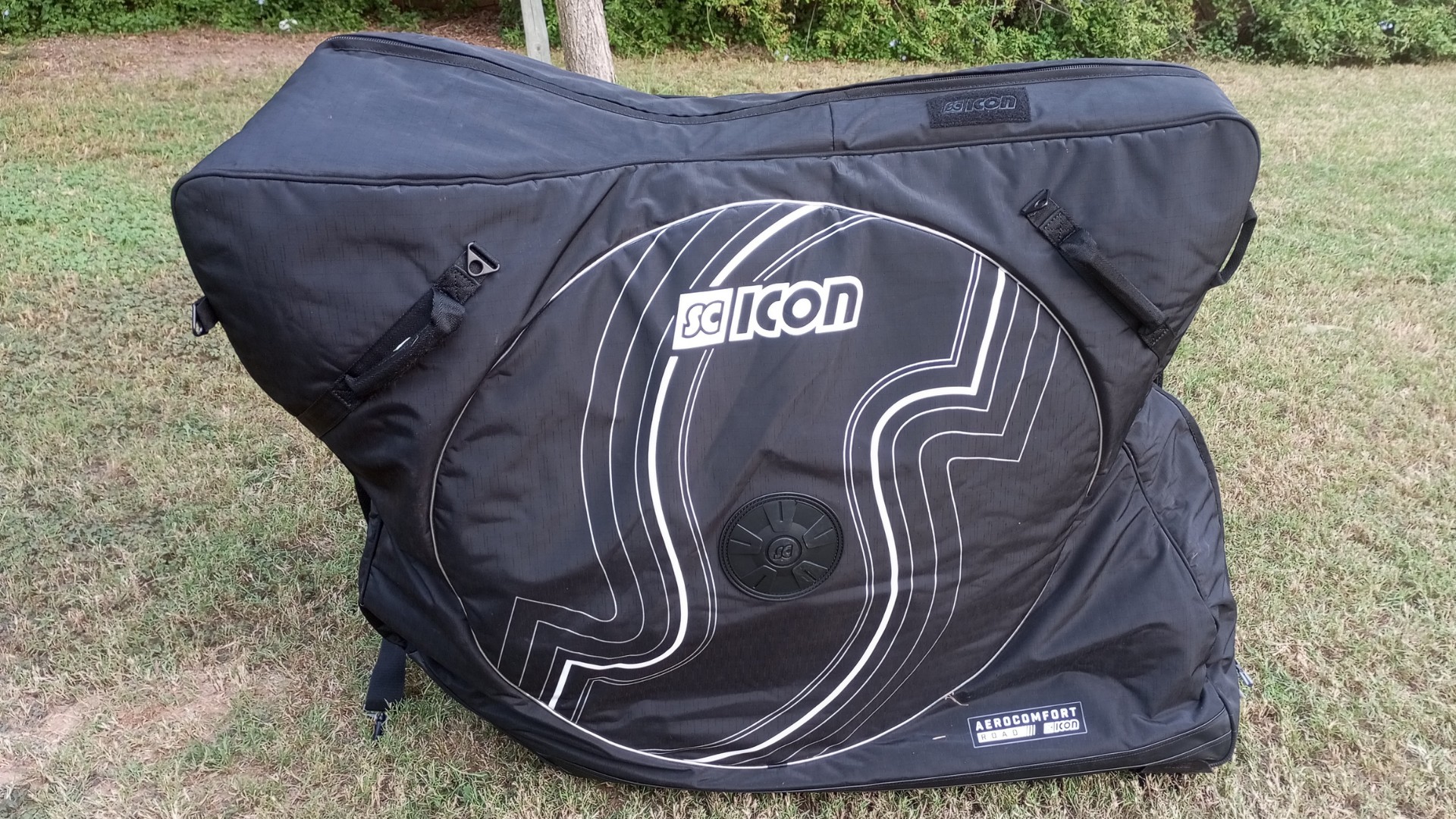 Scicon Aerocomfort 3.0 Bike Bag with a bike packed away inside
Scicon Aerocomfort 3.0 Bike Bag with a bike packed away inside
- Pros:
- Easy and quick to pack
- Minimal disassembly required
- Internal metal frame for added protection
- Cons:
- Questionable protection for the rear derailleur
- Bulky and may not fit in small cars
4.2. Evoc Bike Travel Bike Bag
The Evoc Bike Travel Bike Bag is a soft case known for its ease of use and ample padding. It features a large side opening for easy loading and external wheel compartments.
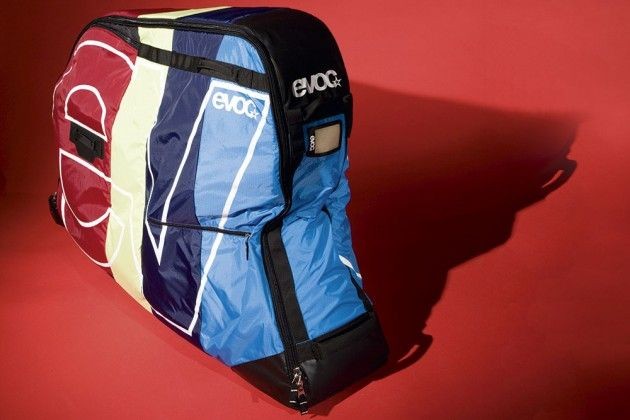 Multi-coloured Evoc bike travel bag
Multi-coloured Evoc bike travel bag
- Pros:
- Easy to use and store
- Plenty of padding for protection
- External wheel compartments
- Cons:
- Less protection than a hard case
- Soft case may not withstand rough handling
4.3. VeloVault2 Bike Box
The VeloVault2 Bike Box is a robust hard case designed for maximum protection. It is made in the UK and features quality fixings and a spacious interior.
 Blue Velovault2 bike box
Blue Velovault2 bike box
- Pros:
- Spacious and sturdy
- High-quality fixings
- Excellent protection for the bike
- Cons:
- Heavy, which may limit baggage allowance
- Bulky and requires significant storage space
4.4. Thule RoundTrip Pro XT Bike Bag
The Thule RoundTrip Pro XT Bike Bag is a versatile option with a built-in work stand. It offers a combination of softshell protection and structural support, making it ideal for cyclists who want a convenient and functional case.
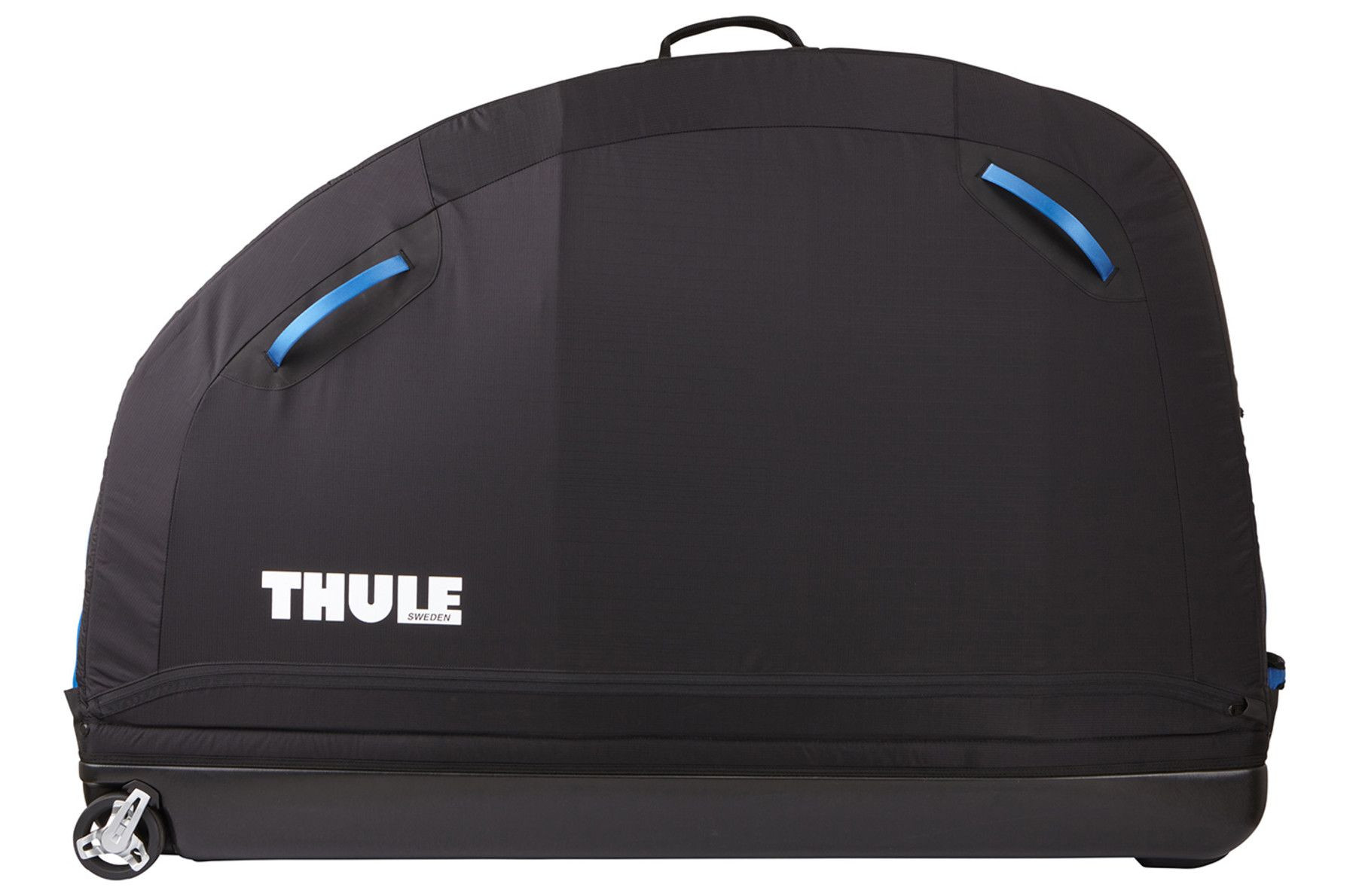 Thule Round Trip Pro XT bike bag
Thule Round Trip Pro XT bike bag
- Pros:
- Doubles as a work stand
- Integrated wheels for easy transport
- Provides good protection
- Cons:
- More expensive than other options
- Some weak spots in the design
4.5. Orucase B2 Bike Travel Case
The Orucase B2 Bike Travel Case is known for its portability and compact size. It is lightweight and includes backpack straps, making it easy to carry in various travel situations.
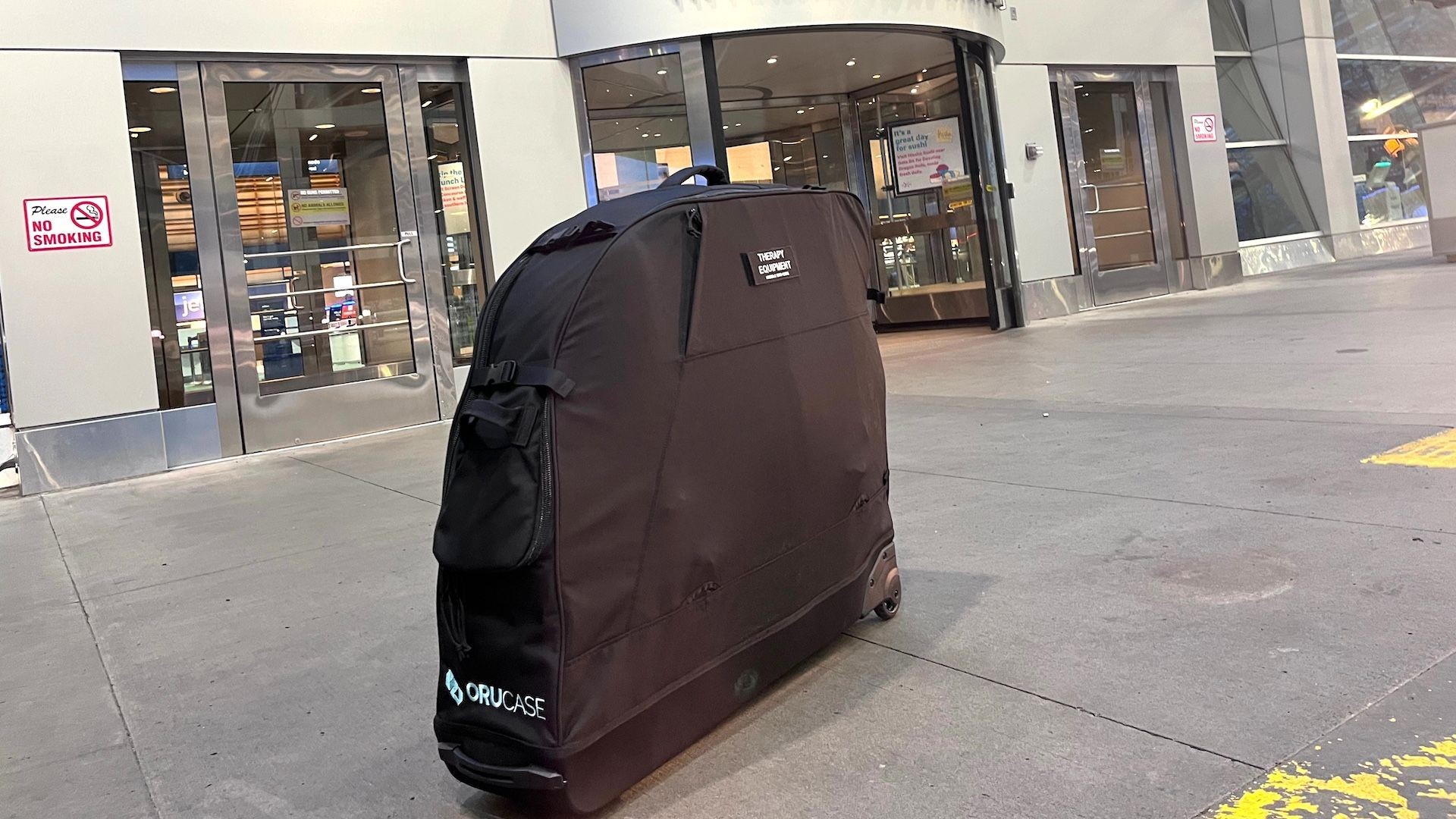 Orucase B2 Bike Travel Case
Orucase B2 Bike Travel Case
- Pros:
- Highly portable and lightweight
- Compact and easy to store
- Includes backpack straps for easy carrying
- Cons:
- Requires significant disassembly of the bike
- Can be lopsided when packed, making it prone to tipping
4.6. Scicon Pocket Bike Bag
The Scicon Pocket Bike Bag is a basic and lightweight option ideal for train travel and keeping your car interior clean. It packs down into itself and is very affordable.
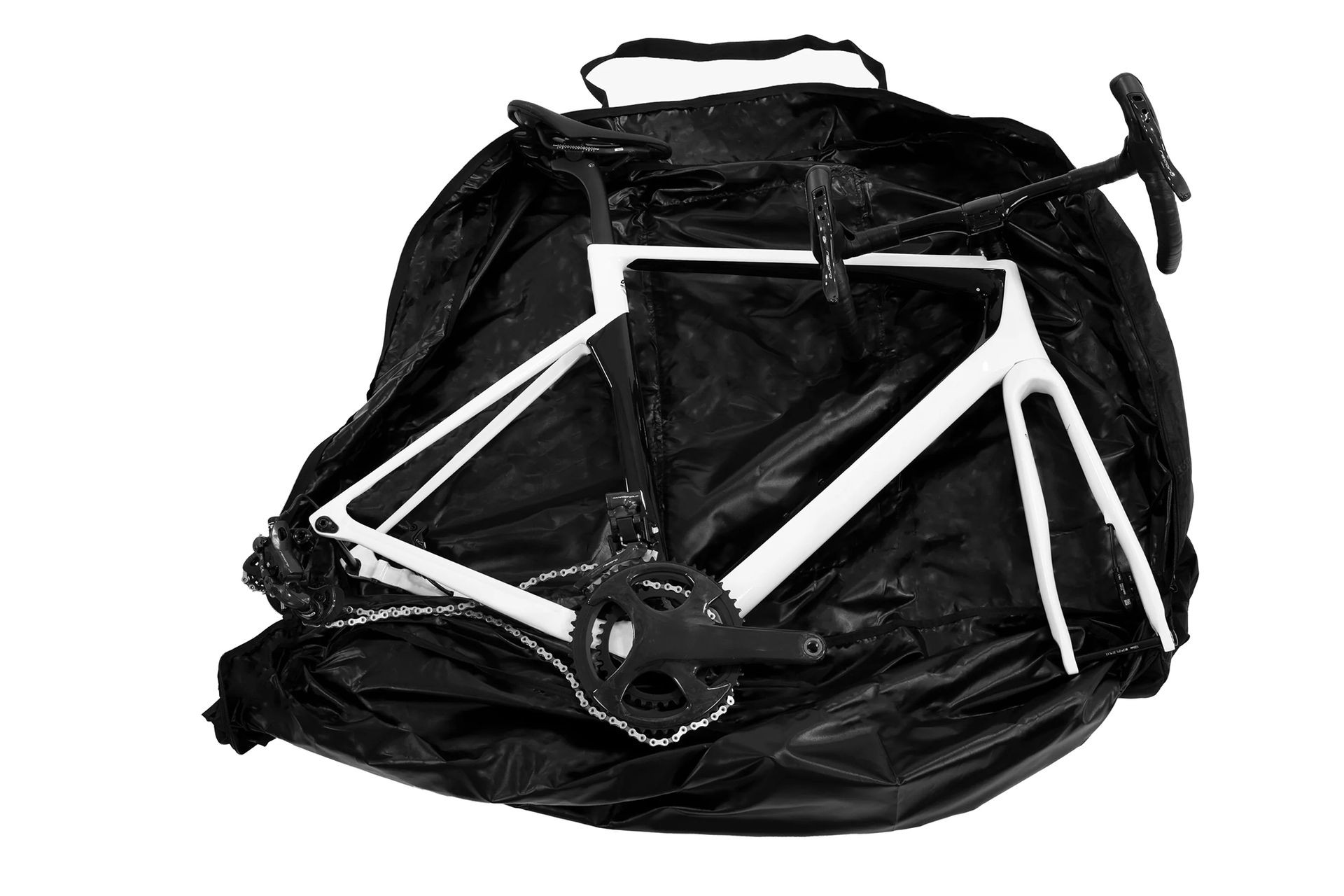 Scicon Pocket Big Bag, a soft very basic bike bag ideal for putting your bike in the car on a train
Scicon Pocket Big Bag, a soft very basic bike bag ideal for putting your bike in the car on a train
- Pros:
- Super light and compact
- Packs into itself for easy storage
- Very affordable
- Cons:
- Offers very little protection
- Not the easiest to carry
5. How To Pack Your Bike In A Bike Case For Air Travel?
Packing your bike properly is crucial to ensure its safety during air travel. Follow these steps for a secure and efficient packing process:
5.1. Gather Your Tools And Supplies
Before you start, gather the necessary tools and supplies:
- Allen wrenches
- Pedal wrench
- Bubble wrap
- Foam tubing
- Packing tape
- Zip ties
- Rag or cloth
5.2. Disassemble Your Bike
- Remove Pedals: Use a pedal wrench to remove the pedals. Wrap them in bubble wrap and secure them.
- Deflate Tires: Partially deflate the tires to reduce the risk of bursting due to air pressure changes.
- Remove Wheels: Remove the wheels and store them in separate wheel compartments or wrap them in bubble wrap.
- Remove Seatpost: Remove the seatpost and saddle. Mark the insertion point to easily reassemble it later.
- Handlebar Removal:
- Option 1: Remove the handlebar from the stem.
- Option 2: Remove the handlebar and stem together from the steerer tube.
- Rear Derailleur: Undo the rear derailleur but leave the chain intact. Protect it with bubble wrap.
5.3. Protect The Frame And Components
- Wrap the Frame: Use bubble wrap and foam tubing to protect the frame, especially in areas where other items might rub against it.
- Secure Components: Use zip ties to secure loose components and prevent them from moving during transit.
- Padding: Add extra padding to vulnerable areas like the fork ends, dropouts, and derailleur hanger.
5.4. Pack The Bike In The Case
- Follow Manufacturer Instructions: Refer to the bike case manufacturer’s instructions for specific packing guidelines.
- Secure the Frame: Use internal straps to secure the frame to the case’s frame.
- Distribute Weight: Distribute the weight evenly within the case to maintain balance.
- Pack Tools and Accessories: Pack your tools and accessories in a separate bag or compartment to prevent them from damaging the bike.
5.5. Final Checks
- Check for Loose Items: Ensure no loose items inside the case could damage the bike.
- Close and Secure the Case: Close the case and ensure all latches and locks are securely fastened.
- Weigh the Case: Weigh the case to ensure it meets the airline’s weight restrictions.
6. What Are Some Tips For Traveling With A Bike Case?
Traveling with a bike case can be challenging, but these tips can help make the process smoother:
6.1. Check Airline Regulations
Before you travel, check your airline’s regulations regarding bike transportation, including weight and size restrictions, fees, and any specific requirements.
6.2. Arrive Early At The Airport
Allow extra time at the airport for check-in, as oversized baggage may require additional handling.
6.3. Label Your Bike Case
Clearly label your bike case with your name, address, phone number, and email address. Include a copy of your itinerary inside the case.
6.4. Consider Travel Insurance
Purchase travel insurance that covers your bike in case of damage or loss during transit.
6.5. Use A Luggage Transport Service
Consider using a luggage transport service like SIXT.VN to handle the logistics of transporting your bike case, providing a hassle-free travel experience.
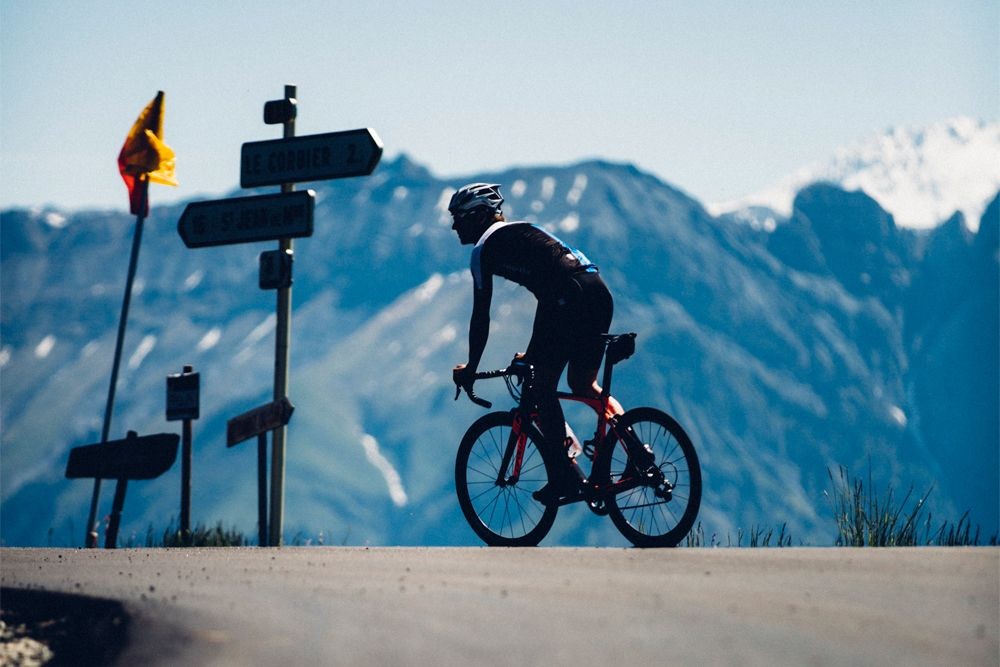 Road cyclist riding with a mountain in the background
Road cyclist riding with a mountain in the background
6.6. Be Prepared For Inspection
Be prepared for airport security to inspect your bike case. Ensure you have any necessary tools to open and reassemble the case if required.
7. What Is The Cost Of Traveling With A Bike Case?
The cost of traveling with a bike case includes the price of the bike case itself and any additional airline fees.
7.1. Bike Case Costs
Bike cases range in price from around $200 for basic soft bags to over $1000 for high-end hard cases.
7.2. Airline Fees
Airline fees for transporting bikes vary widely. Some airlines treat bikes as standard checked baggage, while others charge extra fees, ranging from $50 to $200 per flight.
7.3. Luggage Transport Services
Luggage transport services like SIXT.VN charge a fee based on the distance and size of the bike case. Contact SIXT.VN for a quote.
8. What Alternatives Are There To Bringing Your Own Bike?
If you prefer not to travel with your bike, consider these alternatives:
8.1. Renting A Bike In Vietnam
Many bike rental shops in Vietnam offer high-quality road bikes, mountain bikes, and touring bikes. Renting can be a convenient option, especially for shorter trips.
8.2. Shipping Your Bike
Shipping your bike to Vietnam via a courier service is another option. This can be more expensive than flying with your bike but can be more convenient.
8.3. Buying A Bike In Vietnam
If you plan to spend an extended period in Vietnam, consider buying a bike locally. You can find a range of bikes at different price points.
9. What Are The Benefits Of Using SIXT.VN For Your Cycling Trip To Vietnam?
SIXT.VN offers a range of services to enhance your cycling trip to Vietnam:
9.1. Airport Transfer Services
SIXT.VN provides reliable airport transfer services to transport you and your bike case to your accommodation.
9.2. Luggage Transport Services
SIXT.VN can handle the transportation of your bike case and other luggage, allowing you to travel hassle-free.
9.3. Bike Rental Services
SIXT.VN partners with local bike rental shops to offer a wide selection of high-quality bikes for rent.
9.4. Guided Cycling Tours
SIXT.VN offers guided cycling tours of Hanoi and other regions of Vietnam, providing expert local knowledge and support.
9.5. Accommodation Booking
SIXT.VN can assist you in booking accommodations that are bike-friendly and conveniently located for your cycling routes.
9.6. Travel Insurance
SIXT.VN offers travel insurance options to protect you and your bike during your trip.
10. FAQs About Bike Cases For Air Travel
10.1. Can I bring my bike as checked baggage?
Yes, most airlines allow you to bring your bike as checked baggage, but you may need to pay an additional fee. Check with your airline for specific regulations and fees.
10.2. Do I need to deflate my tires when flying with a bike?
Yes, it is recommended to partially deflate your tires to reduce the risk of bursting due to air pressure changes during the flight.
10.3. What is the best way to protect my bike during air travel?
The best way to protect your bike is to use a high-quality bike case, either a hard case or a soft bag with ample padding. Disassemble your bike properly, protect the frame and components with bubble wrap and foam tubing, and secure everything inside the case.
10.4. Can I leave my Di2 or AXS batteries on my bike?
If you are travelling by land or sea, we see no harm in this. However, if you are travelling by air, it’s worth checking with the airline, but their general guidance would be to remove them and put them in your carry-on. At the very least, you know you will have them when you reach your destination.
10.5. What size bike case do I need?
The size of the bike case you need depends on the size of your bike frame. Measure your bike’s length, height, and width, and choose a case that is slightly larger to accommodate it comfortably.
10.6. Are there weight restrictions for bike cases?
Yes, most airlines have weight restrictions for checked baggage, including bike cases. Check with your airline for specific weight limits to avoid excess baggage fees.
10.7. Can I put other items in my bike case?
You can put other items in your bike case, such as cycling gear, clothing, and tools, but be mindful of the weight limit. Make sure to distribute the weight evenly and protect the bike from any potential damage.
10.8. Will my travel insurance cover my bike if its damaged?
Generally, yes, as most cover all luggage; however, the value is down to individual policy, and not all will cover excess baggage. We recommend looking at the best bicycle insurance, as these are much better tailored to dealing with these scenarios and will handle any claims made more effectively.
10.9. What should I do if my bike is damaged during air travel?
If your bike is damaged during air travel, report it to the airline immediately and file a claim. Take photos of the damage and keep all documentation, including your baggage claim tag and ticket.
10.10. Where can I buy a bike case?
You can buy bike cases at bike shops, sporting goods stores, and online retailers like Amazon, REI, and specialized cycling websites.
Planning a cycling trip to Vietnam requires careful consideration of how to transport your bike safely. By choosing the right bike case and following these tips, you can ensure your bike arrives in perfect condition, ready for your Vietnamese adventure. Let SIXT.VN handle the logistics, and focus on enjoying the ride!
Ready to plan your cycling adventure in Vietnam? Contact SIXT.VN today for expert advice and convenient travel services!
Address: 260 Cau Giay, Hanoi, Vietnam
Hotline/Whatsapp: +84 986 244 358
Website: SIXT.VN



